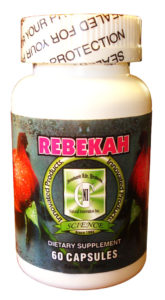Rebekah

Rebekah
Rebekah contains Soy Isoflavones from Soybeans.
Soy Isoflavones
Soy Isoflavones are phytoestrogens found in soybeans.
Phytoestrogens are plant-derived nonsteroidal compounds that possess estrogen-like biological activity.
Soy isoflavones have both weak estrogenic and weak anti-estrogenic effects. They have been found to bind to estrogen receptors-alpha (ER-alpha) and beta (ER-beta). They appear to bind better to ER-beta than to ER-alpha.
Soy isoflavones comprise three main isoflavones and their glycosylated forms. The three main isoflavones are the aglycones genistein, daidzein and glycitein.
The glycosylated forms of genistein are genistin, 6’’ -O-malonylgenistin , and 6’’-O-acetylgenistin; those of daidzein are daidzin, 6’’ -O-malonyldaidzin and 6’’ -O-acetyldaidzin, and those of glycitein are glycitin, 6’’ -O-malonylglycitin and 6’’ -O-acetylglycitin. The malonyl glycosides of genistein are the major forms of the soy isoflavones that are found in soybeans. Fermented soy foods, such as tempeh and miso, are rich in the soy isoflavone aglycones. The most sbundant of the soy isoflavones in soybeans are the genistein glycosides (about 50%), followed by the daidzein glycosides (about 40%). The least abundant of the soy isoflavones in soybeans are the glycitein glycosides (about 5 to 10%). Soy protein derived from soybeans contains about 2 mg of genistin and daidzin per gram of protein. In soy germ, the order is different. Glycitein glycosides comprise about 40% of soy germ daidzein glycosides about 50% and genistein glycosides about 10%.
Soy isoflavones have estrogenic activity. Soy isoflavones may have antioxidant activity. They may also have anticarcinogenic, anti-atherorenic, hypolipidemic and anti-osteoporotic activities.
As phytoestrogens, soy isoflavones have two important effects. First, when estrogen levels are high, phytoestrogens can block the more potent forms of estrogen produced by the body and may help prevent hormone-driven diseases, such as breast cancer. Second, when estrogen levels are low, as they are after menopause, phytoestrogens can substitute for the body’s own estrogen, possibly reducing hot flashes and preserving bones. Soy isoflavones may also have antioxidant and anticoagulant effects.
Research indicates that soybean products help protect against heart disease by lowering LDL (“bad”) cholesterol, and
significantly increasing HDL(“good”) cholesterol. Soy seems most effective in levels, its effects are less powerful, and larger amounts are needed to produce the same benefits. Soy products may also inhibit the oxidation of LDL cholesterol, the first step in the accumulation of artery-clogging plaque.
In addition, laboratory studies show the genestein in soy helps prevent blood clots from forming.
Soy isoflavones have weak estrogenic activity. The order of activity in in vivo assays is glycitein greater than genistein greater than daidzein.
They bind to estrogen receptors-alpha and beta. They appear to bind better to estrogen receptor-beta than to estrogen receptor-alpha.
The most studied of the soy isoflavones is genistein. Genistein has been found to have a number of antioxidant activities. It is a scavenger of reactive oxygen species and inhibits lipid peroxidation. It also inhibits superoxide anion generation by the enzyme xanthine oxidase. In addition, genistein,
in animal experiments, has been found to increase the activities of the antioxidant enzymes superoxide dismutase, glutathionine peroxidase, catalase and glutathione reductase. Daidzein and glycitein also appear to have reactive oxygen scavenging activity. However, thease isoflavones have not been studied as much as genistein has.
Regarding possible anticarcinogenic activity, again genistein has been the most studied of the soy isoflavones. Several mechanisms have been proposed for genistein’s possible anticarcinogenic activity. These include upregulation of apoptosis, inhibition of angiogenesis, inhibition of DNA topoisomerase II and inhibition of protein tyrosine kinase. Genistein’s weak estrogenic activity may be involved in its putative activity against prostate cancer.
Other possible anti-prostate cancer mechanisms include inhibition of NF (nuclear factor)-kappa B in prostate cancer cells, downregulation of TGF (transforming growth factor)-beta and inhibition of EGF (epidermal growth factor)- stimulated growth. Genistein’s anti-estrogenic action may be another possible mechanism to explain its putative activity against breast cancer. Additional possible anti-breast cancer mechanisms include inhibition of
aromatase activity and stimulation of sex hormone binding globulin, both of which might lower endogenous estrogen llevels.
The possible anti-atherogenic activity of soy isoflavones may be accounted for, in part, by their possible antioxidant activity, particularly with regard to inhibition of lipid peroxidation and oxidation of LDL. Soy isoflavones may have some cholesterl-lowering activity.
Soy isoflavone’s weak estrogenic effect may help protect against osteoporosis by preventing bone resorption and promoting bone density.
However, the mechanism of this possible effect is entirely speculative at this time.
Soy isoflavones may be helpful in preventing and treating some forms of heart disease and cancer.
They may ameliorate some menopausal symptoms and may be beneficial in preventing osteoporosis.
Epidemiological data suggest that higher intakes of foods containing soy isoflavones are significantly correlated
with reduced incidence of heart disease and some forms of cancer.
Animal, in vitro, and human studies have provided further support for the epidemiological findings. Soy proteins were shown to lower plasma
levels of cholesterol in animal models of hypercholesterolemia, and subsequently, a meta-analysis of human studies has more recently established
that soy consumption is significantly associated with reduction in plasma cholesterol levels in humans, as well.
These effects are largely attributed to the isoflavones components of soy.
Epidemiological data indicate that consumption of soy is particularly associated with reduced risk of breast, lung and prostate cancers, as well as leukemia. Here again, in vitro and animal research has further supported these observations.
Problems associated with menopause, including osteoporosis, also appear to be favorably affected by higher intakes of soy products and by soy isoflavones specifically. The “hot flashes” that some menopausal women experience are significantly reduced in some who consume soy products and/or soy isoflavone supplements. These benefits have been demonstrated in randomized, double-blind studies.
Soy isoflavones have also been shown to prevent bone resorption and to help increase bone density in some in vitro and animal studies.

